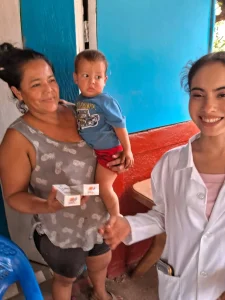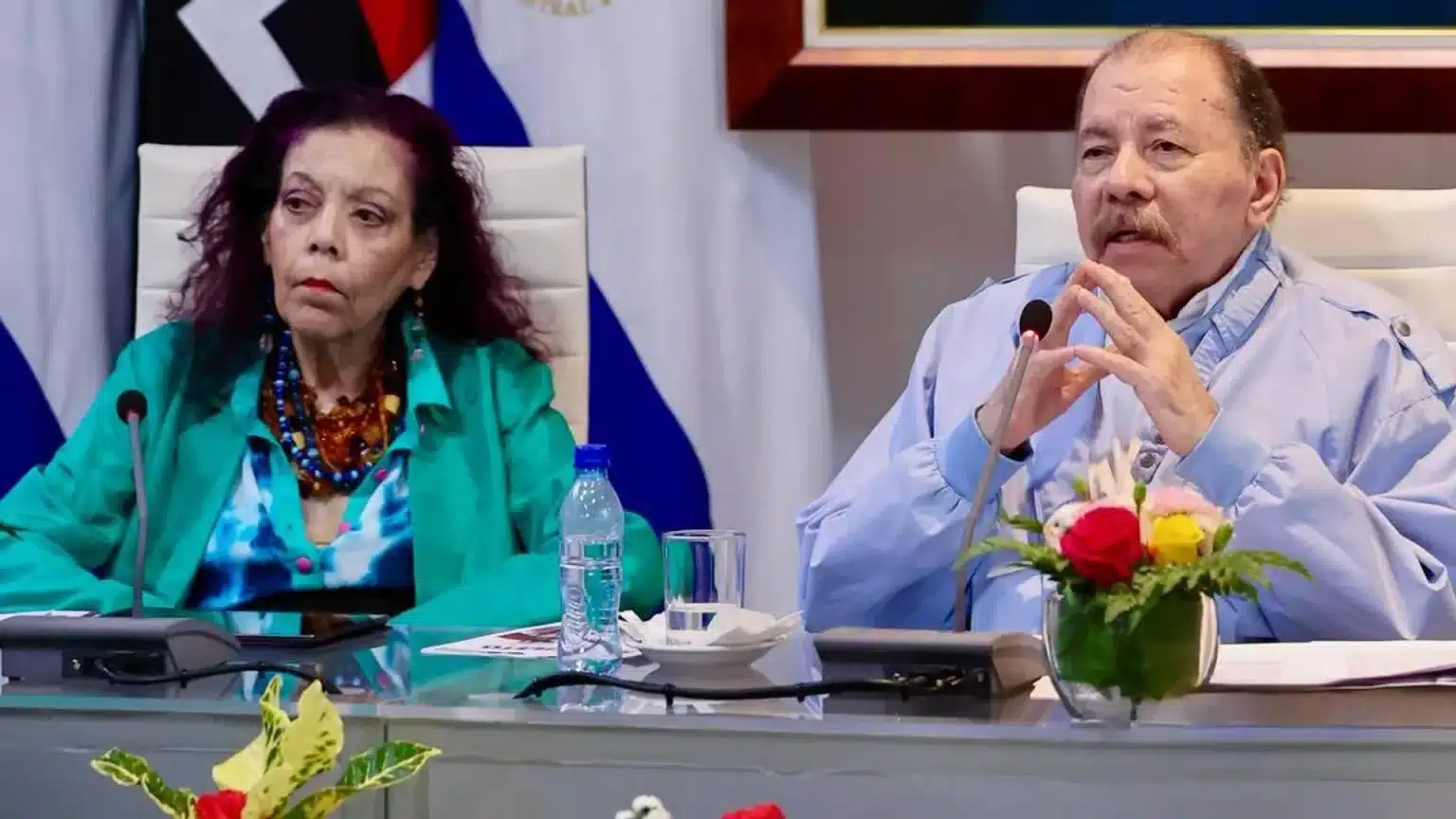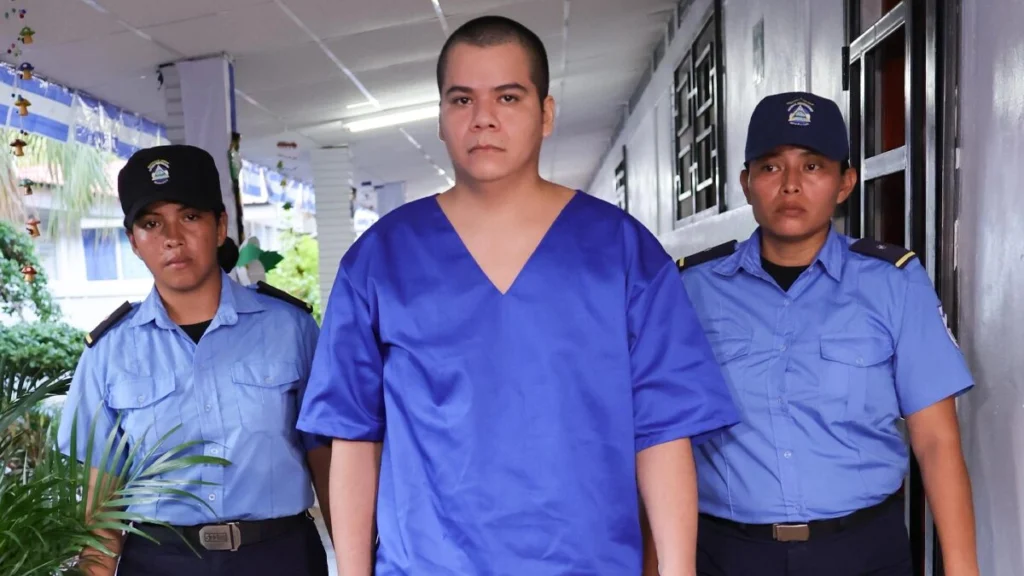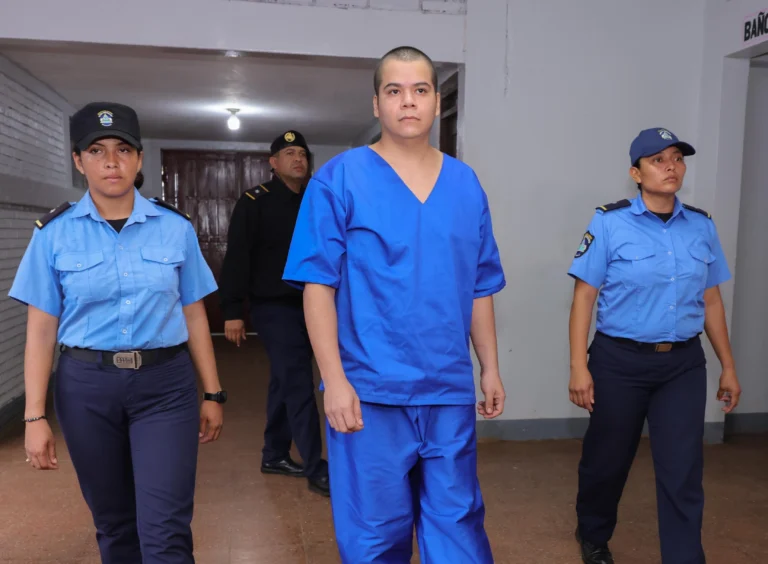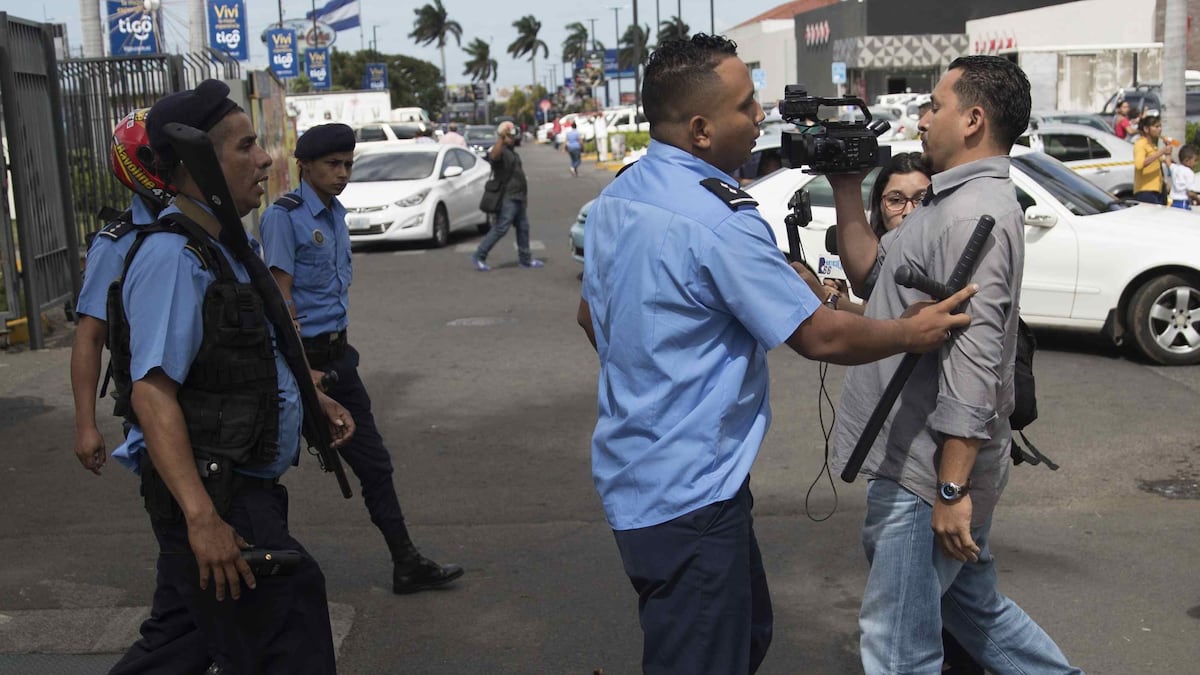July 3, 2025
NicaNotes: Veterans For Peace Delegation Visits Nicaragua:
A Call for Solidarity and Truth in the Face of Disinformation — Part One
By Gerry Condon
(Gerry Condon is a Vietnam-era veteran, war resister, and a former president and current board member of Veterans For Peace. He led the first two US veterans’ delegations to revolutionary Nicaragua in 1983-84, and coordinated the Veterans Peace Convoy to Nicaragua in 1987. He also led a Veterans For Peace delegation to Nicaragua in 2019 and the recent one in March of this year. Joshua Shurley teaches political science at Fresno City College. His Ph.D. research focused on the impact of US special operations on civilian populations. He is national vice-president of VFP.)
[This is Part One of the report of the March 2025 Veterans for Peace trip to Nicaragua. The veterans’ delegation also gave a report back on a June 22, 2025, webinar with the Nicaragua Solidarity Coalition.]

Group photo of the Veterans For Peace delegation at a memorial to Sandino. Left to right: Al Glatkowski, Dan Shea, Gerry Condon, delegation translator Becca Maholly Renk, Chris Smiley, Douglas Ryder, Michael Kramer, Joshua Shurley. Photo: Coleen Littlejohn
In a powerful demonstration of international solidarity, seven U.S. veterans visited Nicaragua in mid-March as part of an official delegation of Veterans For Peace (VFP). As the U.S. continues to grapple with mounting challenges such as increasing authoritarianism, mass deportations, and the dismantling of social services, the delegation’s visit underscores a vital message: that solidarity between the peoples of the U.S. and Nicaragua can help break through the lies and disinformation promoted by powerful interests and reveal how the struggles of ordinary people are interconnected.
Veterans For Peace, a 40-year-old U.S.-based organization founded by former members of the military, is committed to “restrain our government from intervening, overtly and covertly, in the internal affairs of other nations.” The veterans’ delegation to Nicaragua was more than just a show of solidarity—it was an act of resistance against the disinformation campaign that has consistently misrepresented the Sandinista government and the realities of life in Nicaragua.
Delegation members were VFP Vice President Joshua Shurley, VFP Board Member Gerry Condon, VFP Communications Director Chris Smiley, At-Large Member Alvin Glatkowski of Virginia, and Michael Kramer, Douglas Ryder and Dan Shea, three presidents of their respective VFP chapters in Northern New Jersey; Raleigh/Durham, North Carolina; and Portland, Oregon.
The Struggles We Share
Nicaragua, the third poorest nation in the Western Hemisphere, has long been a symbol of revolutionary spirit. The country’s history is marked by the struggle of the Sandinista National Liberation Front (FSLN) against U.S.-backed dictatorship and imperialism. Despite facing U.S.-led economic sanctions and limited resources, Nicaragua has made remarkable strides in lifting people out of poverty. The FSLN’s commitment to poverty reduction, and providing free, quality healthcare and education for all serves as an inspiring example of what can be achieved when the needs of the people are prioritized over profit.
In contrast, the U.S. is experiencing its own form of decline. Increasing authoritarianism, the dismantling of democratic institutions, and mass deportations are signs of a system that prioritizes corporate power over human dignity. Many Americans are now beginning to face the harsh realities that countries like Nicaragua have endured for decades. From climate change-induced ecosystem collapse to the ongoing threat of nuclear war, it is clear that the U.S. is not immune to the consequences of imperialism and neoliberalism. The challenge is no longer confined to far-off nations but is increasingly felt on U.S. soil.
What We Saw and What We Learned
During the delegation’s visit, members traveled to Matagalpa and San Ramón, a region where the transformative effects of Sandinista policies were visible. From universities in rural communities to healthcare facilities that provide free services to all citizens, the delegation witnessed firsthand the immense efforts made to ensure that no one is left behind. This contrasts sharply with the past, when U.S.-backed governments turned a blind eye to the needs of the most vulnerable.
Dramatic Reductions in Maternal and Infant Mortality
Since the Sandinista government’s return to power in 2007, Nicaragua has made major strides in maternal healthcare, largely through its maternity wait homes (known in Spanish as Casas Maternas) program. These community-based centers offer free, comprehensive care to women with high-risk pregnancies—providing safe housing, prenatal education, and transport to hospitals when it’s time to give birth. During our recent Veterans For Peace delegation, we visited the Casa Materna “Martina Alemán” in Matagalpa, where we saw firsthand how this program supports women in remote areas. It’s part of a broader public health effort that has helped reduce maternal mortality by 70% and infant mortality by 56%.

The VFP delegation met with staff and expectant mothers at the Casa Materna Martina Aleman in Matagalpa. Photo: Veterans For Peace
“What a difference it makes when a government prioritizes the needs of the poorest and most vulnerable. And what a contrast to the U.S., where things are moving in exactly the opposite direction,” said Joshua Shurley, national vice president of Veterans For Peace.
Meanwhile, in the United States, maternal health outcomes continue to worsen—especially for women of color. Many areas lack basic access to maternity care with hospitals closing and services becoming more centralized and expensive. These outcomes are deeply connected to ongoing political attacks on reproductive healthcare, including abortion bans, clinic closures, and restrictions that make even basic care harder to access. Pregnant people face rising out-of-pocket costs, limited or no paid leave, and increasing legal risks just for seeking care.
The Casa Materna model—and Nicaragua’s broader approach—shows what’s possible when healthcare is treated not as a commodity, but as a public good and a human right. For Veterans For Peace, these lessons are profound. One overarching mission of Veterans For Peace is to build a culture of peace—and what we saw in Nicaragua reminds us that peace isn’t just the absence of war, but the presence of justice, equity, and care for the most vulnerable.
U.S. Economic Warfare Continues
Nicaragua’s achievements are all the more impressive given the continuing U.S. economic warfare against its progressive government. The US has imposed sanctions on Nicaragua since 2018, when it opposed an IMF loan to Nicaragua to aid its finances after the US-inspired coup attempt, and then used its influence to block loans from the World Bank and similar institutions. Nicaragua’s finance minister said that this costs the country around $500m annually in development funding that would go to its poorest communities.
There are now threats of new sanctions. The US has been attempting to stop loans from the Central America Bank for Economic Integration, and is also threatening to attempt to exclude Nicaragua from the CAFTA trade agreement. The Trump Administration recently threatened higher tariffs on Nicaraguan exports than those applying to its neighbors, although these higher tariffs have been suspended until July.
Sustainable Energy and Food Sovereignty
Nicaragua’s ability to withstand punishing U.S. economic warfare (aka “sanctions”) is partly a result of its focus on “food sovereignty” and renewable energy, making progress in sustainable agriculture and energy production. Ninety per cent of the food that Nicaraguans eat is grown in Nicaragua, and over 70% of Nicaragua’s energy needs are met by wind, solar, geothermal, biomass and hydroelectric.

The VFP delegation was covered extensively by Nicaraguan media. Here, several outlets are interviewing VFP Board member Gerry Condon. Photo: Veterans for Peace
Free Education for All
Free education is a cornerstone of Nicaragua’s development strategy, with investments in vocational schools and colleges to empower the youth. The delegation visited INATEC (National Technological Institute) in Granada, where students are learning vocational skills as part of the FSLN’s broader commitment to its most valuable national treasure: its youth. These students are being empowered to build their futures through education, a stark contrast to the eroding access to education and opportunities that many youth in the U.S. face today.
The U.S. veterans also visited a school for the arts in Masaya, further underscoring the importance of cultural expression and the value of the arts in building a free and just society. Nicaragua’s commitment to fostering creativity and providing artistic education stands in stark contrast to the growing marginalization of the arts in many U.S. educational systems.
U.S.-Backed Attempted Coup in 2018
Additionally, the delegation traveled to sites in Masaya where brutal violence occurred during the U.S.-backed coup attempt in 2018. Western media portrayed these events as a crackdown by the Nicaraguan government on peaceful protesters. However, firsthand accounts from those on the ground reveal a different story: the so-called “peaceful protesters” were violent mobs, funded through shadowy arms of the U.S. intelligence sector, whose aim was to return the country to neoliberal rule. The truth, as witnessed by the veterans’ delegation, is far more complex than the simplistic narrative often pushed by mainstream media.
This is Part One of a two-part series. Part Two will appear soon!
For more information about the work of Veterans for Peace, check out the VFP website.
Briefs
By Nan McCurdy
100 Families Receive Homes
The Managua mayor’s office turned over the keys to more than 100 houses to an equal number of families in the Camino del Río housing development, located in District VI of the capital, adding to the1,800 new houses so far in the project, according to Mayor Reyna Rueda. The goal is to build more than 5,300 houses in this subdivision of affordable housing. Rueda added that the access road to this sector, which will benefit the inhabitants of Villa Jerusalén and Sabana Grande, is 40% finished along with the construction of 60 blocks of streets within the two new housing complexes. The construction of the primary and secondary school for this neighborhood has made significant progress. See photos: https://radiolaprimerisima.com/cien-fam ... as-nuevas/ (La Primerisima, 28 June, 2025)
Overpass on Heroes of the Insurrection Highway Ready
Co-President Rosario Murillo reported that, in commemoration of revolutionary leader Julio Buitrago Urroz, an overpass on the North Highway and the Heroes of the Insurrection Highway will be inaugurated on July 15. This is part of a beltway that goes from the north highway around to the South Highway near 7Sur. This work strengthens the road infrastructure of Managua and will reduce traffic congestion. The overpass is part of a much larger project to provide a better connection between the North Highway and the South Highway which will speed up the transfer times from one point to the other. See photos: https://radiolaprimerisima.com/listo-tr ... era-norte/ (La Primerisima, 26 June 2025)
Massive Participation in Multi-hazard Drill
SINAPRED (National System for Prevention, Mitigation and Attention to Disasters) reported that 2.3 million people in neighborhoods throughout the country participated in the drill on June 26 which put into practice multi-hazard, family, community, municipal, departmental, regional and institutional response plans for dealing with the effects of hurricanes, flash floods, landslides, volcanic eruptions, earthquakes, and tsunamis, among other phenomena. Participants, organized in 43,845 community, work center, institutional and municipal brigades, participated in 12,646 scenarios that were prepared for this exercise in 8,007 neighborhoods and communities. According to the report, 66,719 citizens participated in the 1,682 health units, 178 maternity homes and 101 homes for people with special needs, including health personnel, patients and visitors. The educational system reported the participation of 1.2 million in 9,612 public and private educational centers. Meanwhile, the municipalities reported the participation of 22,953 citizens. Other mobilizations included the National Police – 8,742 members; Nicaraguan Army – 10,000 troops; and 2,754 United Firefighters in 228 stations nationwide. The private sector reported the participation of 31 free trade zones, 106 markets, 18 commercial and recreational centers, 268 private institutions, 69 cooperatives and 233 churches of different denominations. Over 200 communities vulnerable to tsunami threats were mobilized in coastal areas. SINAPRED said that of the 60 sirens of the early warning system in the Pacific, 58 activated automatically; the rest were activated manually.
Drill Turns into Real Disaster Response in Some Areas
According to SINAPRED, in the Santa Elena neighborhood of District 6 of Managua, a special plan different from the national drill had to be developed due to heavy rains—communication mechanisms were activated from the national, municipal and district levels with the support of SINAPRED’s Mobile Data Center and deployed to guarantee autonomous communications and technological support at the affected site. At that place, ten action protocols were tested including self-protection measures and evacuation of 1,520 people from 313 homes. The skills of the local brigades were tested in real time with the rescue of 10 people, who were transferred to the field hospital deployed for initial care. A temporary shelter was set up in the Luz de Cristo Church, with kitchen, health, sleeping and psychosocial support areas. The damage assessment team was also activated with the participation of 12 technicians from national institutions.
The SINAPRED report adds that there were also scenarios of intense rains which caused floods in the communities Ochomogo, San Rafael, Barraza, San Roque, Barrio Cuba, Pozo de Oro, Las Banderas, El Jabillo, San Isidro, Apompoa 2 (San Miguel), San Antonio 1 and 2, La Sirena, Potosí 2 (Paso de Piedra), Calle En Medio (San Gregorio) and El Limonal 2. Community leaders activated family and community plans for the protection of life. The local Brigade of San Rafael, in coordination with the municipal emergency brigade, activated an emergency alert for the search and rescue of two people who were swept away by the strong currents of the Ochomogo River who were transferred to the health post in the San Rafael community. They also carried out an evacuation of people located on the banks of the river to safe places and temporary shelter in the Joshua 1-9 Church with the support of brigadistas and community members. (La Primerisima, 26 June 2025)
Sandinistas Reenact 1979 Retreat to Masaya
On Sunday, June 27th, thousands of Sandinistas took part in a caravan of motorcyclists to commemorate the tactical retreat [el repliegue] from Managua to Masaya on June 27, 1979, as part of the preparations for the celebration of the 46th anniversary of the Sandinista Revolution on July 19th. Despite the heavy rains in some regions, the enthusiasm of the people was palpable. Red and black flags, slogans and whistles accompanied the caravans in memory of the historic struggle and the popular victory of 1979. The motorcade was commemorating the 46th anniversary of the withdrawal from Managua that was a fundamental step in the overthrow of the Somoza dictatorship. The dictatorship was bombing its own cities, including Managua and the retreat was in great part a life-saving effort. Historical combatant Francisco Salinas, who has always been a part of the revolutionary project, stated that “Today we are commemorating another year of the Tactical Withdrawal to Masaya with this motorized caravan.” With this activity, the population joined the national celebrations that will culminate on July 19, reaffirming their commitment to keep alive the memory of the revolution. See many excellent photos: https://radiolaprimerisima.com/alegres- ... iempre-19/ (La Primerisima, 28 June 2025)
Chinandega Opens Remodeled Baseball Stadium
The mayor’s office of Chinandega announced it has concluded the rehabilitation of the Efrain Tijerino Mazariego baseball stadium. Mayor Aura Lila Padilla, said the project was carried out by the Sandinista government and benefits the population, local athletes and those who enjoy each game. The remodeling included the construction of the parking lot, the main façade of the stadium, improvements in the playing field, booths, seating and fan areas. Scarth Martinez, coordinator of Sandinista Youth in Chinandega, commented, “We, the youth, feel happy because we are the protagonists [in these sports], in these improvements that our government makes for healthy recreation where you can come and enjoy.” Chinandega continues to advance in the development of the sport which, in addition to the enjoyment of the fans, benefits the merchants who offer their food and projects when there are baseball games in the different championships that are played there. See photos: https://radiolaprimerisima.com/chinande ... e-beisbol/ (La Primerisima, 28 June 2025)
Anniversary of World Court Decision Against the US
Thirty-nine years ago, on June 28, 1986, at the International Court of Justice in The Hague, justice shone in favor of the Nicaraguan people; David defeated Goliath once again. The Court’s ruling was a historic milestone for international law. Nicaragua had sued the United States for financing paramilitary activities and arming the counterrevolution (the Contras), for the mining of ports, damage to the economy and most importantly, loss of human lives, 38,000 at that point in time. Out of 16 judges, 15 voted in favor of the Nicaraguan people. The estimated value that the United States should pay Nicaragua was calculated at $US17 billion. The Nicaraguan team of lawyers, led by Dr. Carlos Arguello, gave moral and patriotic lessons at the highest court in the world, making the peaceful settlement of international disputes prevail as a principle of international public law. At 39 years from that decision, the government of Nicaragua reiterated its commitment and vocation for peace, the defense of the principles of international law as a mechanism for peaceful settlement of international disputes. (La Primerisima, 28 June 2025)
Inspections to Avoid Hiring Child Labor
Ministry of Labor inspectors visited 29 companies last week as part of its activities related to preventing child labor and to protecting adolescent workers 18 and older. According to the report released by the Ministry, 184 agreements have been signed with employers committing to the non-hiring of child labor and 39 certificates were issued to adolescents who met the minimum working age. Of this total, 56% were issued in the department of Estelí. (La Primerisima, 28 June 2025)
External Debt Decreases
The Nicaraguan Central Bank report on the country’s total external debt corresponding to the first quarter of 2025 indicates that the total external debt decreased by US$3.2 million (-0.02%) with respect to the balance of December 2024 (US$15.8 billion). This is the result of the US$40.3 million decrease in the private external debt and the US$37.2 million increase of the public external debt. Disbursements during the quarter were US$749.6 million, of which 85.7 percent came from private creditors and 14.3 percent from official creditors. The main destinations of these resources were the following economic activities: electricity, gas and water (31.9%), commerce (27.8%), financial intermediation (14.8%), manufacturing industry (9.6%), construction (8.0%), mining (5.2%), public administration (1.8%), and other sectors (0.9%). Of the total disbursements, US$642.1 million went to the private sector and US$107.5 million to the public sector.
The external debt service was US$903.9 million in the quarter, of which US$783.6 million were principal payments and US$120.4 million were interest and commission payments. Of the total service paid, 78.2% corresponded to the private sector, and the rest to the public sector (21.8%). In terms of financial conditions, the average term of the private sector’s long-term external debt remained at 14 years with six years for non-financial sector debt and 23 years for the financial sector. The weighted average interest rate was 5.26%. External public debt recorded an average contracted term of 21 years, including a 10-year grace period, with an average interest rate of 2.78%.
The Central Bank also reported that the total external debt (public + private) at the end of the first quarter of 2025, was US$15.8 billion, of which 55.1% (US$8.7 billion) corresponds to the public sector and 44.9% (US$7.1 billion) to the private sector. Of the total external debt, 44.1% was with official multilateral creditors, 31.3% with official bilateral creditors, and 24.6% with commercial banks, suppliers and others. (La Primerisima, 30 June 2025)
https://afgj.org/nicanotes-veterans-for ... n-part-one







